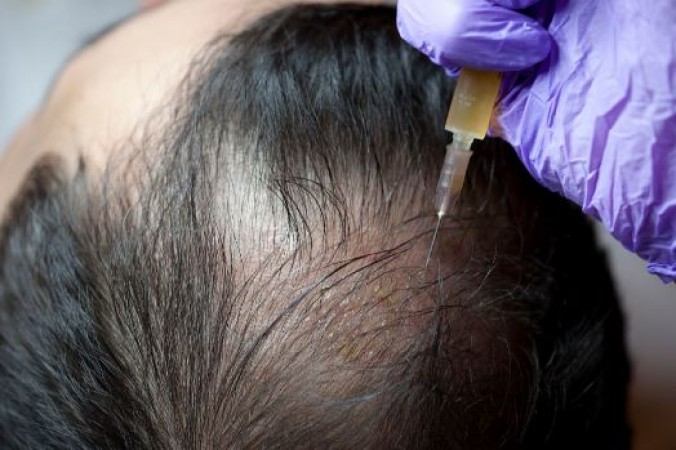
Hair loss is a common concern affecting many individuals due to factors like pollution, poor diet, and lifestyle choices. One of the innovative solutions that have gained popularity in recent years is Platelet-Rich Plasma (PRP) treatment. This article provides a detailed overview of PRP treatment, how it works, and how it can help prevent hair fall and promote hair regrowth.
Understanding PRP Treatment
PRP (Platelet-Rich Plasma) Treatment is a medical procedure designed to promote hair regrowth and improve hair health. It involves the use of a concentration of platelets derived from your own blood, which is injected into the scalp to stimulate hair follicles.
Process of PRP Treatment:
Blood Collection: The first step involves drawing a small amount of blood from the patient’s arm.
Centrifugation: The blood is then placed in a centrifuge, a machine that separates the blood into its different components. This process isolates the platelet-rich plasma from the rest of the blood.
Preparation of PRP: The platelet-rich plasma is then activated with a special solution to enhance its regenerative properties.
Injection: The prepared PRP is injected into the scalp, specifically targeting areas with hair thinning or loss. This helps to rejuvenate hair follicles and stimulate hair growth.
Duration and Frequency: Each PRP session usually takes about 30 to 60 minutes. The treatment is typically performed in multiple sessions, with the exact number and frequency depending on the patient’s individual needs and response to treatment.
How PRP Treatment Helps in Stopping Hair Fall
**1. Stimulates Hair Follicles:
PRP contains growth factors that play a crucial role in the healing and regeneration of tissues. When injected into the scalp, these growth factors stimulate the hair follicles, promoting new hair growth and strengthening existing hair.
**2. Enhances Blood Supply:
The growth factors in PRP also improve blood circulation in the scalp. This enhanced blood flow delivers essential nutrients and oxygen to the hair follicles, which helps in their rejuvenation and reduces hair loss.
**3. Reduces Inflammation:
PRP has anti-inflammatory properties that help reduce inflammation around the hair follicles. This can be particularly beneficial for individuals experiencing hair loss due to inflammatory conditions.
**4. Improves Hair Density and Thickness:
Regular PRP treatments can lead to increased hair density and thickness. Patients often notice fuller and healthier hair as a result of the stimulation provided by the PRP injections.
Benefits of PRP Treatment
Non-Surgical: PRP is a minimally invasive procedure, meaning there is no need for surgery. It involves a simple injection process, reducing the risks and recovery time associated with more invasive hair restoration methods.
Natural Process: Since PRP uses platelets derived from the patient’s own blood, there is minimal risk of allergic reactions or complications. This makes it a safer option for many individuals.
Minimal Downtime: The procedure generally requires little to no downtime. Most patients can resume their normal activities immediately after the treatment.
Effective for Various Types of Hair Loss: PRP can be effective for different types of hair loss, including androgenetic alopecia (genetic hair loss) and hair thinning due to other factors.
Potential Risks and Considerations
While PRP treatment offers several benefits, it is important to be aware of potential risks and considerations:
Cost: PRP treatment can be expensive, and multiple sessions may be required to achieve desired results. The cost may not be covered by insurance.
Not Suitable for Everyone: PRP may not be effective for everyone, especially those with certain medical conditions or advanced hair loss. A thorough consultation with a medical professional is necessary to determine if PRP is a suitable option.
Possible Side Effects: Although rare, some patients may experience minor side effects such as swelling, redness, or discomfort at the injection sites. These are usually temporary and resolve on their own.
Varied Results: Results from PRP treatment can vary from person to person. Some individuals may experience significant improvement, while others may see more modest results.
Consulting with Experts
Before undergoing PRP treatment, it is crucial to consult with a qualified healthcare provider or dermatologist who specializes in hair restoration. They can assess your overall health, review your medical history, and determine if PRP is the right treatment for you.
In conclusion, PRP treatment is a promising option for addressing hair loss and promoting hair regrowth. By understanding how PRP works and discussing it with a healthcare professional, you can make an informed decision about whether this treatment is right for you.
Is Eating Almonds With or Without Skin Better for Health?
Do These 3 Yoga Asanas Daily to Boost Self-Confidence and Stay Fresh Throughout the Day
Boils and Pimples on the Scalp During the Rainy Season: How to Get Rid of Them